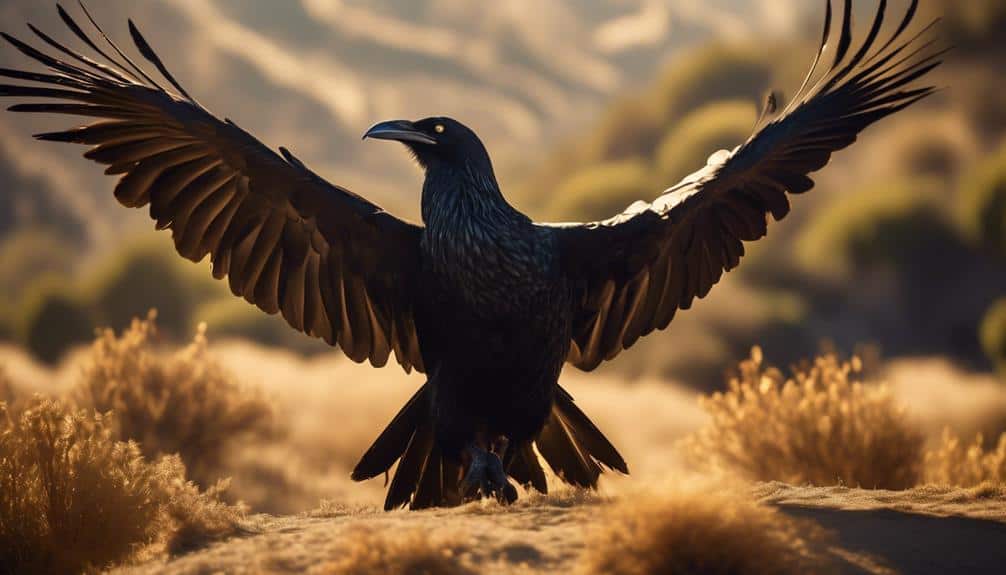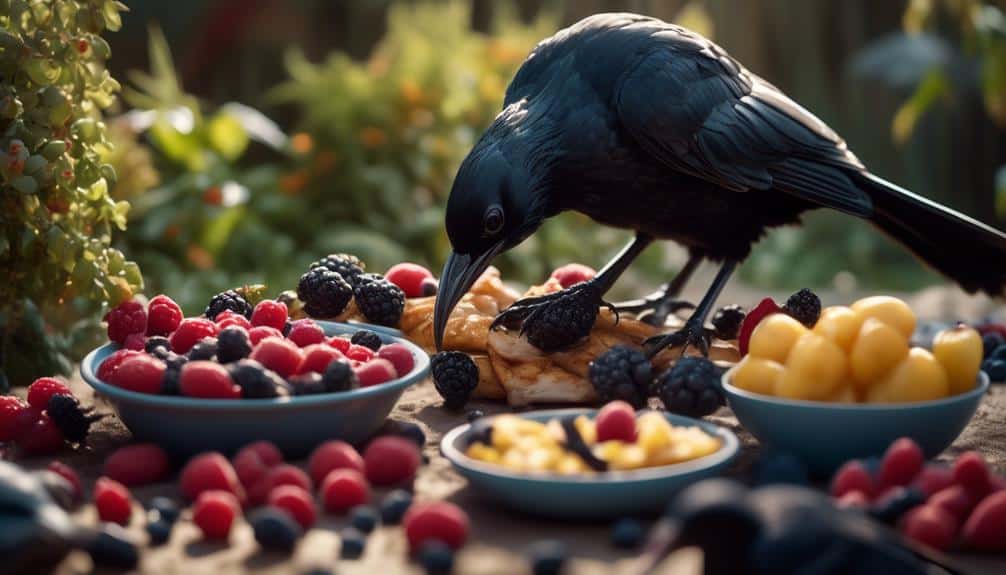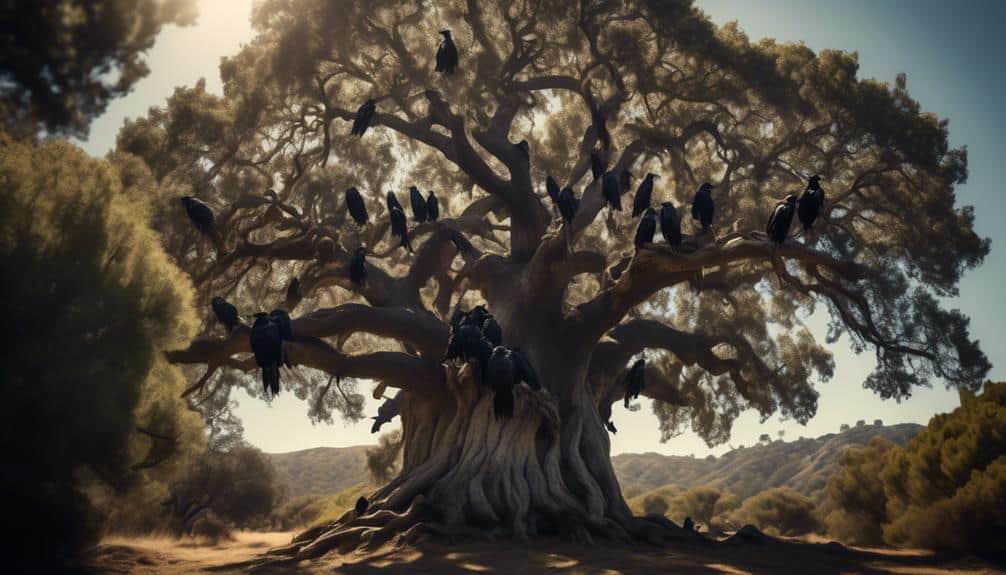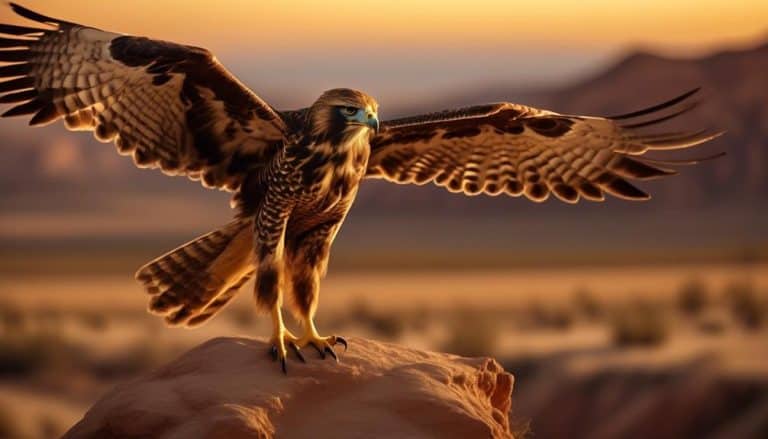I know what you might be thinking – big black birds in California? Isn't that just a common crow? Well, not quite.
While crows are indeed prevalent in the state, there are other impressive avian species that fit the description as well. These birds possess an air of mystery, with their dark plumage and imposing size.
But there's more to them than meets the eye. From their unique behaviors and communication methods to their specialized diets and nesting habits, these big black birds have captivated the curiosity of many.
So, join me as we unravel the secrets of these remarkable creatures and discover why they are such an integral part of California's diverse ecosystem.
Size and Physical Characteristics

As I observed the big black birds in California, their size and physical characteristics stood out with remarkable clarity. These birds, known as Common Ravens (Corvus corax), are large in size, measuring between 56 and 69 centimeters in length, with a wingspan of about 115 to 130 centimeters. Their hefty build, weighing around 1.2 to 2 kilograms, gives them a commanding presence in the sky. The Common Ravens possess a jet-black plumage, which adds to their striking appearance.
Their physical features aren't just for show; they've evolved over time to aid in their predator-prey relationships and overall survival. Their strong, sharp beaks enable them to tear apart their prey, which can range from small mammals to carrion. They also have a thick, muscular neck that assists in scavenging and capturing food. Their wings are broad and powerful, allowing for agile flight and efficient hunting. Additionally, their keen eyesight helps them locate prey from great distances.
These evolutionary adaptations have allowed Common Ravens to thrive in various habitats and play an important role in ecosystems by controlling populations of small mammals and cleaning up carrion. Their impressive size and physical characteristics are a testament to their successful adaptation and survival in the natural world.
Habitat and Range

The habitat and range of Common Ravens are diverse, allowing them to adapt and thrive in a variety of ecosystems. These intelligent birds can be found throughout California's diverse ecosystems, from coastal areas to mountainous regions and even urban environments. They have an impressive ability to tolerate a wide range of temperatures and habitats, which is why they are able to survive in such diverse areas.
Coastal habitats: Common Ravens can be seen soaring above rocky cliffs, foraging along the shoreline, or nesting in the trees near the coast. The sound of their deep, resonant calls echoes through the coastal fog, adding an eerie yet captivating element to the landscape.
Mountainous regions: These majestic black birds can be spotted effortlessly gliding through the crisp mountain air, their sleek feathers glistening in the sunlight. They are known to build their nests on high tree branches, providing them with a commanding view of their surroundings.
Urban environments: Common Ravens have successfully adapted to urban areas, where they scavenge for food in trash cans and make use of man-made structures for nesting. Their adaptability and resourcefulness in these human-altered habitats are a testament to their resilience.
Migration patterns of Common Ravens in California vary depending on food availability and weather conditions. Some populations are sedentary, remaining in their territories year-round, while others undertake seasonal movements in search of food. These movements can span hundreds of miles, showcasing the versatility and adaptability of these remarkable birds.
Behavior and Communication

Observing the behavior and communication of Common Ravens provides fascinating insights into their social dynamics and complex vocalizations. These large black birds are highly intelligent and have a wide range of vocalizations that they use to communicate with one another. Ravens are known for their ability to mimic other sounds, including human speech. They've a repertoire of calls, including croaks, caws, and rattles, which they use in different contexts to convey different messages.
One of the most interesting aspects of raven behavior is their flocking behavior. Ravens are highly social birds and often gather in large groups, known as 'unkindness' or 'congress' of ravens. Flocking behavior serves various purposes, such as foraging, defense, and social interaction. These groups often engage in aerial displays, swooping and diving together in intricate patterns. Flocking also provides safety in numbers, as the group can collectively defend against predators.
Communication within the flock is crucial for maintaining social cohesion. Ravens use a combination of vocalizations, body language, and physical contact to communicate with one another. They can communicate their intentions, emotions, and even coordinate group activities through these signals. For example, when a raven discovers a food source, it will emit a specific call to alert other members of the flock. This communication helps to ensure that all members of the group benefit from the resources available.
Studying the behavior and communication of Common Ravens not only provides valuable insights into their social dynamics but also highlights their remarkable intelligence and adaptability. These birds aren't only fascinating to observe but also serve as important indicators of ecosystem health and functioning.
Diet and Feeding Habits

Studying the dietary preferences and feeding habits of Common Ravens reveals their adaptability and resourcefulness in obtaining nourishment. These intelligent birds have a diverse range of feeding patterns and foraging techniques that allow them to thrive in various environments.
- Scavenging: Common Ravens are well-known scavengers, often seen feeding on carrion and garbage. Their strong beaks and agile bodies enable them to tear through tough flesh and access food sources that other birds might find challenging to reach.
- Hunting: Despite their scavenging behavior, Common Ravens are also skilled hunters. They've been observed catching small mammals, birds, reptiles, and insects. Their ability to strategize and work in pairs or groups enhances their hunting success.
- Food caching: Common Ravens possess excellent memory and often engage in food caching. They hide surplus food in various locations, such as tree crevices or underground, to consume later when food is scarce. This behavior demonstrates their forward-thinking nature and preparedness for lean times.
The adaptability of Common Ravens extends beyond their feeding habits. They can exploit a wide range of food sources, displaying remarkable resilience and ensuring their survival in changing environments. These birds are truly masters of obtaining nourishment through their diverse feeding patterns and foraging techniques.
Reproduction and Nesting

Reproduction and nesting habits of Common Ravens provide insight into their breeding strategies and habitat preferences. Common Ravens are monogamous birds, meaning they form long-term pair bonds. Mating rituals begin in late winter or early spring, with pairs engaging in aerial displays, vocalizations, and courtship flights. These displays help strengthen the pair bond and establish territories.
Nesting behavior of Common Ravens is fascinating and complex. They are known to build large, sturdy nests made of sticks and lined with soft materials such as fur, feathers, and moss. These nests are typically located in tall trees, on cliffs, or even on man-made structures like telephone poles. Ravens are opportunistic nesters and will sometimes use abandoned nests of other birds.
To better understand the nesting behavior of Common Ravens, let's explore their nesting habits in a table format:
| Nesting Behavior | Description |
|---|---|
| Nest Construction | Large, sturdy nests made of sticks |
| Nest Location | Tall trees, cliffs, and man-made structures |
| Nest Material | Soft materials like fur, feathers, and moss |
| Nest Reuse | Opportunistic nesters, may use abandoned nests of other birds |
The nesting behavior of Common Ravens demonstrates their adaptability and resourcefulness in finding suitable nesting sites and materials. These strategies contribute to their successful reproduction and survival in various habitats.
Conservation and Threats

The nesting behavior of Common Ravens provides valuable insights into their reproductive strategies and habitat preferences, but it's also important to examine the conservation and threats facing these remarkable birds.
- Illegal hunting: Common Ravens face the threat of illegal hunting, which not only disrupts their populations but also disrupts the delicate balance of the ecosystem they inhabit. This activity is driven by various factors such as the demand for their feathers, eggs, and body parts in the black market.
- Population decline: The population of Common Ravens has been declining steadily over the past few decades. This decline can be attributed to various factors, including habitat loss, pollution, and climate change. As their natural habitats are destroyed or altered, the ravens struggle to find suitable nesting sites and food sources.
- Competition with other species: Common Ravens face competition for resources from other bird species, such as crows and hawks. Their ability to adapt and thrive in different habitats is being challenged as these competitive species encroach upon their territories.
To ensure the survival of Common Ravens, it's essential to address these threats through measures such as stricter enforcement of anti-poaching laws, habitat conservation, and the promotion of sustainable land management practices. By protecting these birds, we not only preserve a unique and iconic species but also safeguard the overall biodiversity of the ecosystems they inhabit.
Frequently Asked Questions
Can These Big Black Birds Fly Long Distances?
Yes, these big black birds can indeed fly long distances. They have evolved various physiological adaptations, such as strong wings and efficient respiratory systems, allowing them to cover vast distances during migration.
How Do These Birds Defend Themselves From Predators?
When it comes to defending themselves, these big black birds in California have developed impressive predator evasion strategies. They employ defensive behaviors like flying in large groups, making loud calls, and even dive-bombing potential threats.
Are There Any Known Health Risks Associated With These Birds?
There are potential health hazards associated with these birds, as they can carry diseases. It is important to take precautions when coming into contact with them to minimize the risk of transmission.
Do These Birds Migrate During Certain Seasons?
During certain seasons, bird migration patterns can cause fluctuations in the bird population. It is fascinating to observe how these birds navigate long distances to find suitable habitats for breeding or foraging.
What Is the Average Lifespan of These Birds?
The average lifespan of these birds is relatively long, with some individuals living up to 20 years in captivity. Longevity varies based on factors such as diet, habitat, and overall health. In order to accurately assess their lifespan, further research is needed.
Conclusion
In conclusion, the big black birds in California possess remarkable physical characteristics and exhibit fascinating behaviors.
Their wide range of habitats and effective communication methods contribute to their survival.
These birds have a diverse diet and unique feeding habits that sustain their population.
Additionally, their nesting and reproductive patterns play a vital role in their conservation efforts.
However, they also face threats that require attention and conservation measures to ensure their continued existence.







